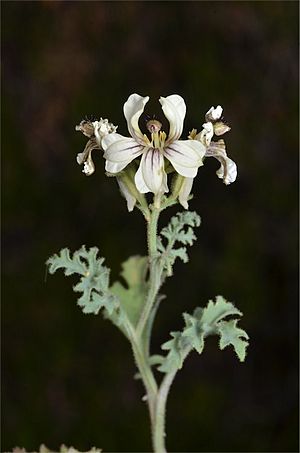Streaked goodenia facts for kids
Quick facts for kids Streaked goodenia |
|
|---|---|
 |
|
| Goodenia calcarata | |
| Scientific classification | |
| Genus: |
Goodenia
|
| Species: |
calcarata
|
| Synonyms | |
|
Pictophyta calcarata F.Muell. |
|
Goodenia calcarata, commonly called the streaked goodenia, is a special flowering plant that grows only in Australia. It's an annual herb, which means it grows from a seed, flowers, makes new seeds, and then dies, all in one year. This plant stands upright and has leaves that are shaped like eggs or are longer and narrower. These leaves often have small teeth along their edges. The streaked goodenia produces beautiful white, cream, or pink to purple flowers that sometimes have brownish marks. After the flowers bloom, they turn into small, oval-shaped fruits.
Contents
What Does Streaked Goodenia Look Like?
The streaked goodenia is an upright plant that grows each year. It can reach a height of about 60 centimeters (about 2 feet). Its leaves are often egg-shaped, wider at the top and narrower at the bottom, or they can be longer and more oval. Some leaves might even look like a lyre, which is a musical instrument. They have small teeth along their edges and are usually between 20 to 50 millimeters long and 10 to 35 millimeters wide. Each leaf has a stalk, called a petiole, which can be up to 20 millimeters long.
The flowers grow in clusters called racemes, which can be up to 150 millimeters long. Each flower has a small stalk, called a peduncle, that is 2 to 7 millimeters long. At the bottom of these stalks are small, leaf-like parts called bracts. Each individual flower sits on an even smaller stalk, called a pedicel, which is 10 to 25 millimeters long.
The plant has narrow, oval-shaped sepals (which are like small leaves that protect the flower bud), about 5 millimeters long. The petals, which are the colorful parts of the flower, are white, cream, or pink to purple and are 10 to 15 millimeters long. The lower parts of the flower's petals, known as the corolla lobes, are 6 to 9 millimeters long and have small "wings" that are 1.5 to 2 millimeters wide.
Streaked goodenia flowers from June to December. After flowering, it produces an oval-shaped fruit called a capsule, which is 12 to 15 millimeters long.
How It Got Its Name
The streaked goodenia was first officially described in 1853 by a scientist named Ferdinand von Mueller. He first gave it the name Picrophyta calcarata. He wrote about it in a science journal called Linnaea: ein Journal für die Botanik in ihrem ganzen Umfange, oder Beiträge zur Pflanzenkunde. Later, in 1867, von Mueller decided to change its name to Goodenia calcarata. This new name was published in another one of his works called Fragmenta Phytographiae Australiae.
Where Does It Grow?
The streaked goodenia likes to grow in rocky areas. You can find it in several parts of Australia. It grows in South Australia, the very southern part of the Northern Territory, and west of a town called Tibooburra in New South Wales. It also grows in the southwestern part of Queensland.
Protecting This Plant
The streaked goodenia is currently listed as "near threatened" by the Northern Territory Government. This means that while it's not in immediate danger of disappearing, its numbers are getting low, and it needs to be watched carefully to make sure it stays safe in the wild.

